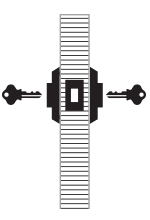
Purchasing new door hardware is a great way to add detailed style with a significant impact. Adding new door hardware also requires advanced knowledge of dimensions, including door thickness and backset size, and other details such as function and handing. Let’s break it all down so you get the appropriately sized products.
In addition to the explanations below, we also offer a short video detailing the difference in door hardware functions on our YouTube channel.
Interior Door Hardware Functions
Passage
The knobs or levers on a passage set turn and operate a latch but don’t lock. They are typically used on interior doors or doors with a separate deadbolt. Passage sets are ideal for closets, hallways, or rooms where no locking mechanism is needed.
Privacy
A privacy set features a latch with a locking mechanism. A privacy pin next to the knob or lever provides locking through the plate or rosette. Privacy sets are ideal for bathrooms, bedrooms, or rooms where a locking mechanism is needed.
Double Dummy
A double dummy set includes two door sets with no lock or latch. The knobs or levers on this set don’t turn or operate a latch. Double dummy sets are ideal for closet doors, pantry doors, or side-by-side French doors used with roller catch, flush bolts, or surface bolts. They are surface mounted or thru-bolted.
Single Dummy
A single dummy set includes a door set for one side of the door with no lock or latch. The knobs or levers on this set don’t turn or operate a latch. A single dummy set is ideal for closet doors, pantry doors, or side-by-side French doors used with roller catch, flush bolts, or surface bolts. It is surface mounted to the door.
Exterior Door Hardware Functions
Entry Handleset
For our one-piece and sectional entry sets, the door is opened by an exterior thumb latch with a passage knob or lever on the interior. Our Tall Plate Entry Sets are opened via a knob or lever on both sides. For all entry sets, there is a keyed lock cylinder on the deadbolt’s exterior side, while a thumb turn is used to lock the door from the inside.

Single Cylinder Deadbolt
A single cylinder deadbolt is a manually operated bolt for entry doors with a keyed cylinder on the exterior and a thumb turn on the interior. Our deadbolts use the common Schlage C Keyway.

Double Cylinder Deadbolt
A double cylinder deadbolt is a manually operated bolt for an entry door with a keyed cylinder on both the door’s exterior and interior sides. Our deadbolts use the common Schlage C Keyway.
Any set with a latch or deadbolt will need to have a backset size (passage, privacy, and entrance sets). This leads us to our next section…
Determining Backset Size and Door Thickness
When ordering door hardware, it is essential to know what will work with your door. If you have a new door, you may need to create your own bore hole. If you are replacing the hardware on an existing door, be sure to measure to determine which backset size will work. Additionally, you will want to measure the thickness of the door to make sure the hardware fits.
Backset
To determine the correct backset measurement for your door, measure the distance from the door’s edge to the center of the bore hole. Two common backset measurements are 2 ¾” and 2 3/8″. Our standard measurement is 2 3/8″.
In addition to the image below, we also offer a short video showing how to measure backset size on our YouTube channel.

Door Thickness
The distance from the inside edge to the outside edge of a door is the door thickness measurement. The industry standard for modern (post-1950) front doors is 1-3/4″. Many interior doors measure 1-3/8″ thick. If your door is thicker than 1-3/4″, we offer a thick door kit.
Our interior hardware sets work with standard door thicknesses between 1-3/8″ to 1-3/4″ thick. Entry sets with a deadbolt work on doors with thicknesses from 1-3/4″ to 2 1/4″ thick.

Door Handing
Door Handing refers to the way a door opens and is determined by the hinge locations. To determine door handing, it’s important to first decide the inside versus the outside of the door.
Outside of a Door
The door’s side where you gain access to a room, or the side facing away from a room. For a bedroom door, the outside would face the hallway.
Inside of a Door
The side of a door that faces the room. For a bedroom door, the inside of the door faces the bedroom.
Hinge Locations
When viewed from the outside, hinges located on the right side mean the door is a Right-Hand door. On the contrary, hinges located on the left side indicate the door is a Left-Hand door. We also have a blog that offers many more details on hinges.

When is handing required?
It is usually a good idea to determine door handing before ordering locks and door hardware. This is especially true for locks with levers, privacy locks, and split finish or split design locks.
If you have any further questions about door hardware, please reach out to our customer service team.









